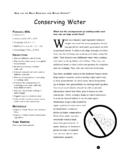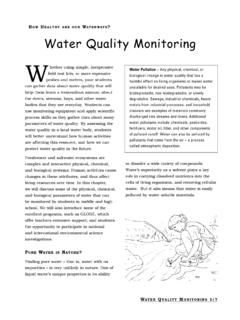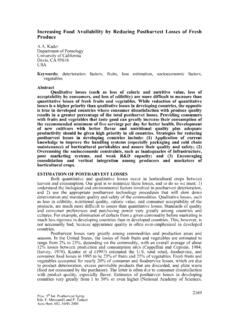Transcription of The Importance of Groundwater D - Longwood University
1 HOW CAN WEHELPMAINTAIN OURWATERSUPPLY?THEIMPORTANCE OFGROUNDWATER4/7Do you drink Groundwater ? In Virginia,chances are about 80% that thewater you and your students drinkand use everyday is partly or wholly fromgroundwater. Ninety-five percent of Virginiansin rural areas are dependent on their ownwells to provide all their water needs. Manytown and city dwellers also drink Groundwater ,as the vast majority of public water supplysystems (2,300 out of 2,500) use groundwatertoo. In fact, 38 of Virginia s 95 counties arecompletely dependent on Groundwater for public water supplies according to the (1990). Fifty-five counties draw half or more of their public water supplies fromgroundwater. The Importance of GroundwaterIn addition to rural households and publicwater supplies that depend on wells andgroundwater, farmers too use Groundwater forirrigating crops and for their animals. Manycommercial businesses and industries inVirginia also depend on Groundwater for theirprocesses and operations.
2 In fact, the largestusers of Groundwater in the Commonwealthare paper companies in Franklin and WestPoint. Other industries rely on clean ground-water for the production of electric power,food, beverages, and material production. Inall, almost 50 billion gallons of groundwaterare used each year in Virginia by farms, publicwater supplies, companies, and families with wells. HOW CAN WEHELPMAINTAIN OURWATERSUPPLY? Groundwater is also very important as it supplies springs, and much of the water inour ponds, marshland, swamps, streams,rivers and bays. Although it is out of sight, it is critical that we learn about Groundwater ,how it is part of the water cycle, and theimportance of protecting and maintaining thequality and quantity of this water GROUNDWATERAs part of the water cycle, some precipitationinfiltrates the ground and percolates downuntil it reaches a depth where all the frac-tures, crevices and pore spaces are saturatedwith water.
3 In this saturated zone called an aquifer the water is called upper surface of a zone of saturation isthe water table. In other words, the watertableis the first occurrence of the water table is the zone of aeration(also called the unsaturated zone). There issome water in the zone of aeration, but it will not flow into a well. So successful wellsneed to be deeper than the water ONE WORD OR TWO?Most dictionaries indicate that the term for underground water can be written as one word, Groundwater or as two, ground water. Someeditors prefer that the single word Groundwater be used when it modifies the next word. For exam-ple, Groundwater quality. Ground water, then,is written as two words when it is not a example, What is the quality of the Groundwater ? But, more and more ecologists, hydrolo-gists, and hydrogeologists are using the singleword Groundwater in all applications as it represents a technical term.
4 In this chapter, wewill use the compound word Groundwater . THEIMPORTANCE OFGROUNDWATER4/8 HOW CAN WEHELPMAINTAIN OURWATERSUPPLY?Aquifersare geologic formations layers ofsand, gravel and rock where significantamounts of water can be stored, transportedor supplied to well or a spring. They are irreg-ular in shape, and can be close to the surface,or very deep. Under your home, there may beseveral aquifers layered one on top of of this, neighboring homes potentiallycan have their wells in different aquifers andexperience different water quality. There are two types of aquifers: confined andunconfined. Unconfined aquifers,generallylocated near the land surface, have no layersof clay (or other impermeable geologic materi-al) above their water table, although they dolie above relatively impermeable clay beds. The upper limit of Groundwater within anunconfined aquifer is the water table. In manyplaces, the water table is actually above thesurface of land.
5 Wetlands are a great exampleof where Groundwater becomes surface in an unconfined aquifer (some-times called a water table aquifer ) is morevulnerable to contamination from surface pollution than a confined aquifer because pollutants on the land surface can enter theunconfined aquifer as water infiltrates the soil. Confined aquifers, on the other hand, havelayers of impermeable material above andbelow them so they are contained withinthese layers. The geologic barriers cause thewater to be under pressure. Fractures, or cracks, in bedrock also are capable of bearing water. In Virginia s coun-ties with Karst terrain(see list on page 4/13), the bedrock aquifers can have large openingswhere Groundwater has dissolved some of therock. These openings can store large amountsof water, accounting for the high yields of wellsin this area. Groundwater flows vertically and horizontallythrough the aquifers at rates that are influ-enced by gravity and the geologic formations of the area.
6 Groundwater can remain in anaquifer for a short period measured in days, orfor many centuries. In fact, the deep aquifersunder parts of Virginia s Coastal Plain are con-sidered fossil aquifers as the water in themhas been there for more than 10,000 FOR ANAQUIFER TORECHARGE?The rate of water inflow into an aquifer (calledthe recharge rate), varies greatly across theDOWATERTABLESMOVE?Yes-the level of water tables does change overtime. For instance, in the summer of 2002, afterthree years of below average precipitation, thou-sands of wells failed due to dropped water tablesacross Virginia. People who had shallow wellsthat were dug or bored were the first to see theeffects of a falling water table as water table levels dropped below the pump intake level. Manystreams and rivers were also drying up as the prolonged drought lowered the water table. Inaddition to droughts, water tables and aquiferscanalso be negatively impacted when we pumpgroundwater out of the earth at a rate faster thanit is replenished.
7 THEIMPORTANCE OFGROUNDWATER4/9 HOW CAN WEHELPMAINTAIN OURWATERSUPPLY?state because Virginia has relatively complicat-ed geology. Factors that influence the rechargerate are: Climate Terrain or topographic relief Geology Type and amount of vegetative ground coverClimate includes the amount of local precipi-tation. Lower precipitation means less water is available for recharging Groundwater levels,while more precipitation means more water is available. The terrain, or topographic relief,will impact the rate of runoff. Rapid runoffdoesn t allow percolation, while standing water allows more percolation. Geology andthe amount of vegetative ground cover willinfluence the capacity of the land surface toaccept infiltrating water. Types of rocks or sediment (including presence of Karst terrainand fractured rocks) also impact the rechargerate, as does the amount of land that hasimpervious surfaces ( , paved surfaces androof tops).
8 In areas with many paved surfaces,the soil is effectively sealed off from precipi-tation. This means that water cannot enter the soil, nor percolate through the soil toreach the water one estimate, the annual recharge to thegroundwater system in the western counties of Virginia is approximately 8 inches, and in the Coastal Plain it is approximately 10inches. Other experts argue that the actualrecharge rates are significantly less. The size of the recharge area for any given welldepends on the depth of the well, and the factors listed above. According to the Virginia Ground WaterProtection Steering Committee s web site( ), Throughout Virginia s five major physiographicprovinces, shallow dug or bored wells are notmuch deeper than the water table and usuallyobtain water that infiltrated relatively nearby,typically less than a mile. Recharge areas fordeeper wells are more variable. Recharge towells drilled into rocks in the Piedmont andBlue Ridge also is fairly localized.
9 Wells drilledinto rocks in the Valley and Ridge sometimesintercept water that has traveled as far as sev-eral miles, particularly in limestone areas withlarge cave systems. In the Coastal Plain, wellsdrilled into deep sand layers can interceptwater that traveled several tens of miles, fromrecharge areas that may be several countiesaway. HOWGROUNDWATERINTERACTS WITHSURFACEWATERS urface water and Groundwater are intimatelylinked to each other within the hydrologiccycle. Groundwater is an important source ofwater for Virginia s streams, rivers, lakes, wetlands and bays. According to the VirginiaDepartment of Environmental Quality, about30 percent of stream flow is from ground-water, although it may reach 100 percent during droughts. Springs, where groundwaterbecomes surface water, are present where the water table intersects the land surface. THEIMPORTANCE OFGROUNDWATER4/10 HOW CAN WEHELPMAINTAIN OURWATERSUPPLY?
10 Virginia has thousands of springs a pointwhere Groundwater discharge becomes sur-face water. Most of Virginia s largest springsare found in the counties with Karst some streams and rivers gain waterfrom Groundwater , other streams help re-charge Groundwater . This occurs when waterfrom a stream infiltrates into the ground. The rate of recharge from streams variesgreatly depending on the season, amounts of precipitation, and other factors. Because of these interactions, the quality of ground-water and surface waters are linked. In fact,studies by the Geological Survey havefound that Groundwater discharge is a signi-ficant source of nitrate load to tidal creeks,coastal estuaries, and the Chesapeake we pump too much Groundwater , the flow of water in springs can be decreased, thusaffecting the receiving waterbody and theplants and animals that use the spring-fedhabitat. For example, a stream that flowsyear-round due to Groundwater could becomean intermittent or ephemeral stream thatflows only a few weeks or months a year.
















